Drying Herbs in the Microwave
- Handmade Bits and Bobs
- August 7, 2022
- Food Preservation / Gardening / Kitchen DIY
- 2 Comments

One of the ways I use the summer garden bounty all year is by drying herbs in the microwave and storing them for later use. Because herb plants often produce prodigious amounts, giving them away can make for some nice—and easy—homemade gifts. Whether you have a few leftover sprigs or a gardenful, drying herbs in the microwave is a handy way to make use of what you have on hand.
I think drying herbs in the microwave makes for the most flavorful end result because it’s so fast: hanging to dry takes weeks, oven and dehydrators take hours, and the microwave takes seconds.
Easy Growers, Close at Hand
For the most part, herbs are fairly easy to grow, both in the garden and in containers. I do both: parsley and basil in bulk, dill, chervil, and cilantro in the garden and mint, thyme, oregano, marjoram, tarragon, sage, rosemary (plus one basil and parsley each) in containers on my back porch so that they’re only a few steps away to snip for the kitchen.
Usually by mid-summer, herbs are growing so fast that I can barely keep up with them, trying to keep them from going to flower. That’s their entire reason for being, of course, to produce flowers to make the seeds to reproduce. Once the seed production gets going, the plants put their energy to that task and they start to fade. Snipping off the budding and flowering tips keeps that at bay and, consequently, creates bushier plants that grow more flowers that, when snipped off, produce even bushier plants, and then…
Well, you see where we’re headed.
Using Fresh Leaves
I use a lot of fresh herbs in my cooking all summer long. In fact, I can’t think of a single summer dish, outside of corn on the cob, that goes un-herbed, including breakfast. Just last week, I served dinner guests zucchini stuffed with basil-parsley-oregano ricotta. Last summer, a dinner party featured ravioli made with basil embedded in the pasta dough—so pretty! (You can read about making a roasted asparagus lasagne with herbed whey from homemade ricotta for an early summer dinner party here.)
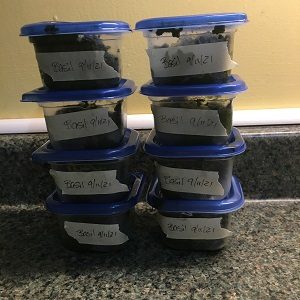

But I can never make a real dent in what grows during the summer, despite my best efforts. I do get some fresh leaves prepared into pesto bases and get those into the freezer for the winter, using both basil and dill. For both, all I do is wash and dry the leaves, then blitz them in the food processor with as little oil as makes a slurry. I spoon this into some 2” x 2” plastic containers and pop them into the freezer to have on hand all winter.
I defrost it, plopping it back into a food processor and jazzing it up from there. For the traditional basil pesto, I add all the other fixings—garlic, salt, pine nuts, parmigano—when it’s out of the freezer, along with more oil to desired consistency. I find the flavorings dull a bit if they’re all added before freezing.
For dill pesto, I add lemon juice, salt, and additional oil to thin. Because I usually use it on a cold pasta or bean salad and add cubed feta to the mix, I omit any other additional cheese in the pesto but to each his or her own! I would imagine the dill would make a nice base for a fish or seafood condiment over the winter, too; as a vegetarian I cannot attest.
I have seen people freeze fresh leaves in ice cube trays covered in olive oil, too, although I have never tried it.
Drying Herbs, Past Tense
And after all that, we arrive at the whole object of this post: drying herbs. I started some years back with the tried-and-true, hanging bunches of herbs to dry. My brother and sister-in-law gave me a lovely iron drying rack that I hung in my kitchen to use. Herbs would be tied into bundles and hung upside down from the rack. It would take some weeks for the herbs to completely dry, then the leaves would be stripped from stems and stored.
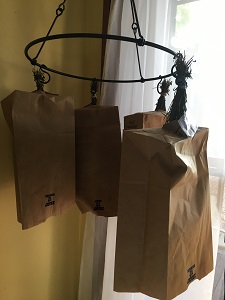
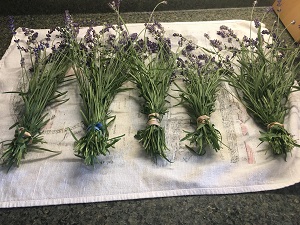
After a few years and gathering additional tips, I tried covering the bunches with paper bags to keep them from turning too brown and help retain their oils, which is what gives the leaves their flavors. It was reasonably successful, and I did that for some years.
But I met my Waterloo with parsley. The store-bought leaves always seemed like tasteless dust to me so I thought home drying would give me a resource when a just a few tablespoons were wanted and buying a whole fresh bunch seemed like overkill.
All my attempts at drying on the rack resulted in brown un-flavorful leaves. Pointless to use, really. But it is my nature, when confronted with less-than-optimal results, to think that there must be a way. I did a bit more searching around and there it was.
Drying Herbs in the Microwave
Well. That had never occurred to me. I found a number of recommendations for drying herbs in the microwave and, I have to tell you, it’s a game changer. It’s fast and the herbs retain far more flavor and their color, making it my go-to.
It’s really about as simple as it can be. Wash and spin dry your herbs. I collect mine in the morning when they’re happiest and process them the same day. Fresh and flavorful is what we’re after.
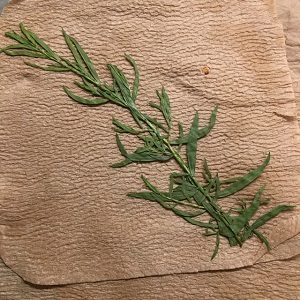
I arrange the herbs in a single layer on several pieces of paper towel, trying not to overlap too much. It’s less an aesthetic consideration than a practical one; it will take longer for a double or triple layer of leaves to dry than a single leaf. I cover with another few layers of paper towel and head to the microwave.
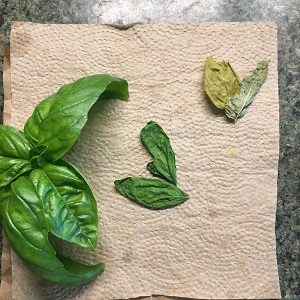
I don’t separate all the leaves from the stems before drying herbs in the microwave, but I do try to minimize the amount of stem, unless you’re planning on saving those, too. It’s a space issue more than anything else but I also don’t want to make myself crazy by separating every leaf from the stem—too time consuming. For big leaves like basil, I do take them all off but for thyme or other small leaves, I just use sprigs or branches.
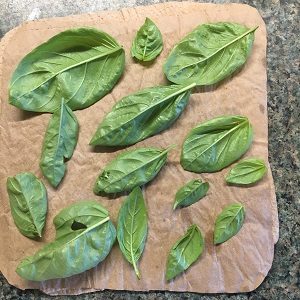
Please consider using Nigella Lawson’s pronunciation; once heard, there’s no going back. (I will object to the YouTube caption, however; she’s clearly making a joke.)
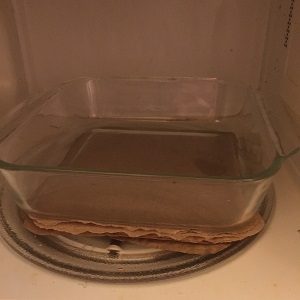
You will need to experiment with your own meecrowavé and the type of herb. Rosemary takes longer for me, dill takes less. Generally, it takes no more than 90 seconds for the longest batch, and most are dried in 60 seconds. When they’re dry, the leaves are more easily stripped off the stem.
Do be careful with woody stems, like rosemary that you buy at the store. They can get pretty dry and then, ahem, problems may arise.
You can put a weight on it (I do this for drying and pressing flowers and also use it for the herbs), which seems to help them dry more uniformly but it’s optional; I’ve had success both ways. Start with 30 seconds on high and check to see if they’re dry. If using the weight (I use a Pyrex baking dish), remove it and give it 15-30 more seconds to allow the moisture in the towels to also evaporate.
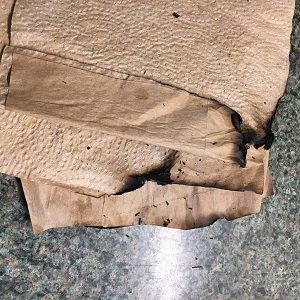
It works with substantial herbs like rosemary and bay leaf as well as very tender ones, like dill and cilantro. And parsley was the revelation. It stays green and tastes like parsley all winter long, right there at your fingertips.
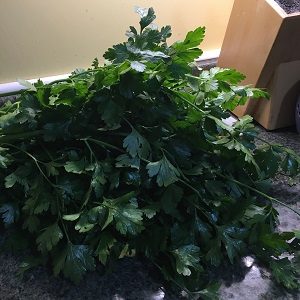

Storing Dried Herbs
I toss my dried herbs every year as they just lose their flavor the longer they sit around. I am lucky that I have a fabulous nearby food co-op, the Honest Weight Food Co-Op, so I buy herbs that I don’t grow in their bulk section and only get a small amount at a time. That way I can replenish from (one hopes) fresher stock when I run out.

For my garden herbs dried in the microwave, I refill my jars about a quarter full but mostly keep the leaves stored in zippered plastic bags in an air-tight plastic container with some silica. I save those desiccant silica packets that come in vitamins, along with sneakers, and a host of other weird places, and this is one of the places I re-use them. The herbs will keep for a year or more without losing their flavor.
Dry Away
If you have excess fresh herbs, give drying herbs in the microwave a try, whether it’s a few stems from the grocery or an armful from the garden. That ubiquitous leftover parsley because you needed two minced tablespoons for that recipe can be dried to have on hand for the next time. As Ma Ingalls used to say in the Little House books, “waste not, want not.”
I hope you find this useful and that you never say microwave the same way from this day forth.
I use the same method for pressing and drying flowers. But that is a story for another day, children.